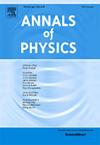Dynamical response and time correlation functions in random quantum systems
IF 3
3区 物理与天体物理
Q2 PHYSICS, MULTIDISCIPLINARY
引用次数: 0
Abstract
Time-dependent response and correlation functions are studied in random quantum systems composed of infinitely many parts without mutual interaction and defined with statistically independent random matrices. The latter are taken within the three Wigner–Dyson universality classes. In these systems, the response functions are shown to be exactly given by statistical averages over the random-matrix ensemble. Analytical results are obtained for the time dependence of the mean response and correlation functions at zero and positive temperatures. At long times, the mean correlation functions are shown to have a power-law decay for GOE at positive temperatures, but for GUE and GSE at zero temperature. Otherwise, the decay is much faster in time. In relation to these power-law decays, the associated spectral densities have a dip around zero frequency. The diagrammatic method is developed to obtain higher-order response functions and the third-order response function is explicitly calculated. The response to impulsive perturbations is also considered. In addition, the quantum fluctuations of the correlation function in individual members of the ensemble are characterised in terms of their probability distribution, which is shown to change with the temperature.
求助全文
约1分钟内获得全文
求助全文
来源期刊

Annals of Physics
物理-物理:综合
CiteScore
5.30
自引率
3.30%
发文量
211
审稿时长
47 days
期刊介绍:
Annals of Physics presents original work in all areas of basic theoretic physics research. Ideas are developed and fully explored, and thorough treatment is given to first principles and ultimate applications. Annals of Physics emphasizes clarity and intelligibility in the articles it publishes, thus making them as accessible as possible. Readers familiar with recent developments in the field are provided with sufficient detail and background to follow the arguments and understand their significance.
The Editors of the journal cover all fields of theoretical physics. Articles published in the journal are typically longer than 20 pages.
 求助内容:
求助内容: 应助结果提醒方式:
应助结果提醒方式:


